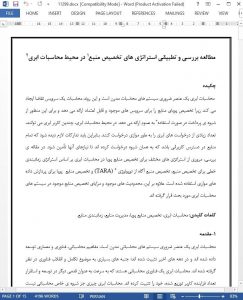Abstract
Cloud computing is an essential ingredient of modern computing systemsCloud computing provides an on demand service because it offers dynamic resource allocation for reliable and highly available services in pay as-you-consume manner to public. In Cloud computing environment multiple cloud users can request number of cloud services in parallel. So there must be a provision that all resources which are made available to requesting user in efficient manner to satisfy their need. In this Survey paper a review of various strategies for dynamic resource allocation in cloud computing is shown based on Linear Scheduling Strategy for Resource Allocation, Topology Aware Resource Allocation (TARA) and Dynamic Resource Allocation for Parallel Data Processing. Moreover limitations significance and advantages of using Resource Allocation in Cloud computing systems is also discussed. Index Terms: Cloud Computing, Dynamic Resource Allocation, Resource Management, Resource Scheduling.
I. INTRODUCTION
Cloud Computing is an essential ingredient of modern computing systems. Computing concepts, technology and architectures have been developed and consolidated in the last decades; many aspects are subject to technological evolution and revolution. Cloud Computing is an computing technology that is rapidly consolidating itself as the next step in the development and deployment of increasing number of distributed application. Cloud computing is nothing but a specific style of computing where everything from computing power to infrastructure, business apps are provided as a service. It’s a computing service rather than a product. In cloud, shared resources, software and information is provided as s metered service over the network. When the end user accesses some service is cloud, he is not aware of where that service is coming from or what is platform being used or where it is being stored.
VI. CONCLUSION
Cloud computing technology is increasingly being used in enterprises and business markets. A review shows that dynamic resource allocation is growing need of cloud providers for more number of users and with the less response time. In cloud paradigm, an effective resource allocation strategy is required for achieving user satisfaction and maximizing the profit for cloud service providers. This paper summarizes the main types of RAS and its impacts in cloud system. Some of the strategies discussed above mainly focus on memory resources but are lacking in other factors. Hence this survey paper will hopefully motivate future researchers to come up with smarter and secured optimal resource allocation algorithms and framework to strengthen the cloud computing paradigm.











